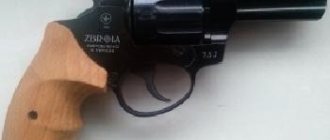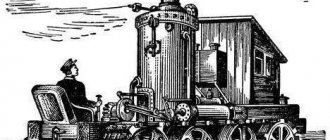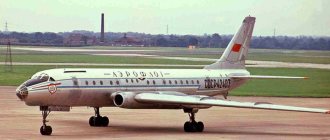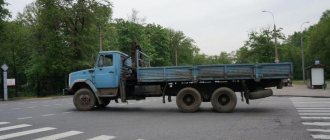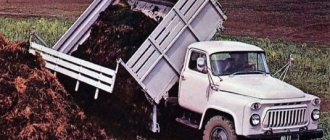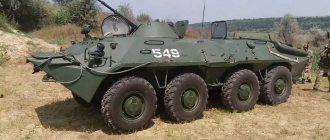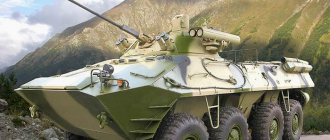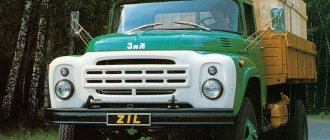The ZIL-133 car was produced at the plant named after I.A. Likhachev in 1975-1999. The three-axle design with high load capacity is designed on the basis of the ZIL-130 truck. The equipment was intended for agricultural enterprises, but modifications were developed in the form of tank trucks, timber trucks, fire escapes, etc.
Car history
The legendary ZIL-130 model is familiar to every car enthusiast. However, how successfully this model was produced in the 70s does not make it timeless. Thus, already in the early 1980s, there was a need for additional modifications that would be more practical and productive.
Oddly enough, there were no existing developments, and the existing ones had to be sent to the plant of another manufacturer. There was nothing left to do but reach into a distant drawer for old ideas and frozen projects.
The ZIL-133, or rather its modifications, became such a project. The model itself served more as a prototype and was extremely rare on the roads even at that time.
The changed design and the same body length did not provide any particular advantages; something else was needed. The differences in the size of the wheelbase, the purpose of the chassis and the carrying capacity of subsequent versions played a significant role in strengthening the Soviet automobile industry.
Links
| : Incorrect or missing image | To improve this article it is desirable:
|
| All terrain | ZIL-157 • ZIL-131 • ZIL-135 • ZIL-4334 • ZIL-49061 |
| Executive models | ZIL-111 • ZIL-114 • ZIL-117 • ZIL-4104 • ZIL-41045 • ZIL-41047 • ZIL-4105 “Armored Capsule” • ZIL-4112R |
| Buses and special equipment | V-1 • ZIL-112S • ZIL-118 • ZIL-158 (LiAZ-158) • ZIL-134 • ZIL-E167 • ZIL-170 • ZIL-2906 |
Cabin and body
The cabin is taken from the parent version “130”. The engineers carried out only some restyling and raised it a little. The front bumper remains white, but the main part of the cabin comes in a variety of color variations.
The abbreviation is emblazoned above the radiator grille. Under the grille there are hooks for towing with a cable. There are side lights on the roof of the body, traditional turn signals on the sides and the main light at the front.
It's very spacious inside. There are three seats - a driver's seat and a combined passenger sofa. Convenient panoramic glass provides a good overview, even despite the forward location of the engine.
Inside, everything is done for the convenience of the driver - ventilation hatches, correct placement of rear-view mirrors and other elements simplify the work process as much as possible. The helmsman's seat is adjustable for tilt and reach, this is enough to set up a workplace for a person of any size.
All controls are copied and pasted from the ZIL-130 cockpit. Thanks to this, the driver did not need to get used to something new. It is worth considering that everything not only remained the same, but also retained the proper convenience.
Even now, measuring sensors and other information devices can hardly be called obsolete. A typical ZIL-133, in addition to being fully equipped and loaded, is capable of towing an additional trailer.
The body structure consists of wood; in some modifications it is made of metal. Representatives with a medium base have only the side sides that fold down, while cars with an extended rear end have folding walls on all three sides. To increase the vector of assignments, you can install an awning on the body using a special frame.
Instead of a cargo compartment for representatives of the “133s”, modules have been and are being developed to solve problems both in agriculture and in other areas of industry. Conveniently, you can order a truck with an empty chassis and install the necessary installation yourself. Relevant for enterprises with narrowly focused activities.
Advantages of the truck
ZIL-133GYA with trailer
The characteristics of the truck allow it to pull a towbar in addition to a loaded body.
ZIL-133GYA is not too sensitive to temperature conditions: it can be operated in the range of -40...+40 degrees. Installing a pre-heater makes starting the power unit easier in cold weather.
The dimensions of the vehicle allow it to demonstrate excellent maneuverability both in dense city traffic and on country roads.
The car cabin is designed in such a way that it can accommodate a driver and two accompanying persons. Good conditions have been created for a driver of any size:
Driver's workplace ZIL 133GYA
- horizontal chair adjustment;
- changing the position of the chair back;
- excellent visibility through the windshield;
- zone control provided by side mirrors;
- convenient location of controls and instruments that are quite informative.
Overall, the model with the hood looked very good. The elongated nose gave the car a certain charm and solidity. It’s not for nothing that hooded trucks are so popular in the USA.
The machine is also very convenient to maintain: the low cost of spare parts and consumables and their widespread availability make it easier to maintain.
Specifications
Power unit
At maximum loads, both tractor-trailers and flatbed trucks can travel at decent speeds while maintaining responsive control.
Engines running on gasoline and diesel produced by ZIL and KamAZ plants still demonstrate excellent qualities in power and economy in use. The tables present the technical characteristics of the main four models: Technical characteristics
| Naming | ZIZ-133G1 | ZIL-133GYA | ZIL-133G40 | ZIL-MMZ-4516 |
| Years of production | 1975-1978 | 1979-1992 | 1992-1999 | 1993-2002 |
| engine's type | ZIL-130 | KamAZ-740.10 | ZIL-645 | |
| Number of cylinders | 8 | |||
| Cylinder arrangement | Longitudinal V-shaped at an angle of 90° | |||
| Number of valves per cylinder | 2*1 | |||
| Volume in cm3 | 5 966 | 10 850 | 8 743 | |
| Horsepower | 150 | 210 | 185 | |
| Maximum torque in newton meters | 402 | 637 | 510 | |
| Compression ratio | 6,5 | 17 | 18,5 | |
| Working fuel | Gasoline A-80 | Diesel | ||
| Fuel tank volume | 125+125 liters | 170 liters | ||
| Maximum speed | 80 km/h | |||
| Cooling | Liquid | |||
Transmission
To change gears in the divider, a pneumomechanical drive is used. Its interesting feature: the actuator activation valve is connected to the pneumatic booster pusher in the clutch drive system.
The driver can, without using the clutch and accelerator pedals, pre-select the appropriate gear in the divider using a switch and then engage it at the right time by simply depressing the clutch pedal.
The convenience of such a device when driving in areas with frequently changing road conditions cannot be overestimated.
The tables present the technical characteristics of the main four models: Transmission
| Naming | ZIZ-133G1 | ZIL-133GYA | ZIL-133G40 | ZIL-MMZ-4516 |
| Years of production | 1975-1978 | 1979-1992 | 1992-1999 | 1993-2002 |
| Gearbox type | Mechanics | |||
| Number of steps | 5 | 9 | 9 | |
| Clutch type | Single disc dry friction | |||
Brake system
The entire brake mechanism consists of four elements.
- The working system is the main brakes operating on air. Braking of the rear and front wheels is divided. Control is carried out using the brake pedal in the cabin and the brake valve using special levers;
- The parking brake aims to ensure immobility on a horizontal surface or a slight slope. The system also operates pneumatically through a special tap. The brake chambers are equipped with special energy accumulators that prevent the rear axle from allowing the wheels to move;
- The auxiliary system is relevant for frequent braking. Relieves some of the load from the main brakes through engine braking. The presence of this element extends the service life of all brakes together;
- Backup system – serves to brake the vehicle in case of failure of the main brakes. Otherwise called emergency. To control it, a parking system crane is used, which activates energy accumulators.
To control all systems in the car, sound and light indications are provided.
Chassis and suspension
The frame consists of two stamped spars, which are connected by cross members. The latter play an important role in the behavior of the frame. Rigidity is ensured by the special structure of the first, fourth and fifth transverse joints.
This is important, since the first one contains supports for the engine and some other working elements; on the third cross member there are frame spars; the fourth consists of two identical halves of the channel section; on the fifth there is a towing device.
The front wheel suspension is dependent on longitudinal semi-elliptic springs and telescopic shock absorbers. The rear wheel suspension is dependent balanced on longitudinal semi-elliptic springs with reaction bars. Frame - spar type, stamped, welded.
| Naming | ZIZ-133G1 | ZIL-133GYA | ZIL-133G40 | ZIL-MMZ-4516 |
| Years of production | 1975-1978 | 1979-1992 | 1992-1999 | 1993-2002 |
| Tires | 260-508Р | |||
| Disc material | Steel | |||
| Front disc type | 7J × 20 260/51 R20 | |||
| Rear disc type | 7J × 20 260/51 R20 | |||
The wheels were produced along with the cars at the Likhachev plant in Moscow.
Car dimensions
| Naming | ZIZ-133G1 | ZIL-133GYA | ZIL-133G40 | ZIL-MMZ-4516 |
| Years of production | 1975-1978 | 1979-1992 | 1992-1999 | 1993-2002 |
| Length | 9,000 mm | 9,040 mm | 9,037 mm | |
| Width | 2,500 mm | |||
| Height | 2 345 mm | 3,358 mm | 2,700 mm | |
| Loading height | 1380 mm | |||
| Wheelbase | 3,710 mm | 4 620 mm | 4 610 mm | |
| Front track | 1,835 mm | 1,848 mm | ||
| Rear track | 1 850 mm | 1,840 mm | ||
| Clearance | 250 mm | 230 mm | ||
| Load capacity | ||||
| Naming | ZIZ-133G1 | ZIL-133GYA | ZIL-133G40 | ZIL-MMZ-4516 |
| Years of production | 1975-1978 | 1979-1992 | 1992-1999 | 1993-2002 |
| Curb weight | 6,875 kg | 7,610 kg | 7,475 kg | 8,600 kg |
| Full mass | 15,175 kg | 17,835 kg | 17,700 kg | 18,600 kg |
Modifications
- The first prototype of the “one hundred and thirty-third” was indexed “133B”. The car was released in 1966. It was a tractor-trailer. The car itself was produced in a circulation not much larger than its parent.
- "ZIL-133N" is once again a trial version for testing. The car was produced in 1968.
- ZIL with an extended base and the ability to pull a trailer was marked “133G”. The sides of the body in this version folded back on all three sides. The modification and its offshoots rolled off the production line until 1987.
- The above-mentioned model has undergone changes to form a truck with an extended wheelbase “ZIL-133G1”. The difference from its younger brother was in the increased volume of the fuel tank. The carrying capacity was 8 tons.
- “ZIL-133G2” is a completely similar copy of “133G1” with an increased lifting capacity of up to 10 tons.
- There were also some construction modifications. The ZIL-133GYA truck crane became one of the last Soviet trucks from the Likhachev plant. To implement the modification, a number of crossings were carried out. The short wheelbase of a dump truck with a chassis adapted for the installation of a KS-3575A crane was completed by the KamAZ-740 power unit. So they produced it until 1992.
- “ZMU-8” on a chassis from “ZIL-133GYA” is an agricultural modification for cultivating fields. ZMU – loader of mineral fertilizers. Production ran from 1979 to 1992.
- At the same base they produced the ZSA-7, a car loader for seeders. Having rolled off the assembly line for the first time in 1979, it was produced for the next 13 years.
- The next experimental version to improve ZIL vehicles was the ZIL-133GYAS model. Came off the assembly line in the years 1980-1984.
- Especially for the Olympics in 1980, the Likhachev plant provided a vehicle for transporting horses - “TS-5982”. The van was placed on a ZIL-133G chassis. Externally the car is attractive. In the field of sports competitions, 6 more representatives of the model were released for the needs of mounted police.
- The mighty prototype "ZIL-E133VYAT" from 1982 was significantly different from its counterparts. This truck tractor had a KamAZ-5E7403 diesel engine equipped with a turbocharger. The cabin was used by the ZIL-133GYA, but was 170 mm higher. In 1988, in an attempt to update the truck, a sleeper was added to the cab, which was revolutionary in the auto industry of those times.
- In the period from 1991 to 1992, the ZIL-133GM was produced as a test sample.
- In 1992, the Smolensk KDM Plant began producing ZIL-133G4 for street cleaning. These included snow removal, dusting and dusting machines. In production to this day.
- “ZIL-133G40” with an extended base and a tarpaulin covering of the body was and is used for transporting various cargoes. Serially produced from 1992 to 1999.
- In parallel with the previous version, a base with an on-board refrigeration unit – “ZIL-133G42” – came off the assembly line. It finds application in relevant areas.
- At the Likhachev plant in the period 1992-99, a truck tractor with a shortened wheelbase was produced - “ZIL-133D42”.
- Another truck tractor, but of a new generation, the ZIL-133VYA, began production in 1995, and is still successfully fulfilling its tasks.
- Based on the ZIL-133, the no less popular ZIL-MMZ-4516 truck was produced. Production period 1993-2002.
Loading platform
The cargo bed, like many other trucks of the era, uses wood and a metal frame. Some modifications were equipped with a completely metal cargo platform. Versions using a medium wheelbase have folding side walls, while cars with an extended rear part of the frame have sides that can be folded out from all sides.
In its standard version, the ZIL 133 is a flatbed truck. However, it is provided for the installation of an awning, which is mounted on a special frame. Thus, its scope of application expanded. In addition, there are other equipment options. For example, instead of a standard flatbed body, a variety of equipment designed for agricultural and industrial activities can be installed here.
It is worth noting that during mass production, this truck was often produced without any equipment, including a loading platform. This was mainly used by various enterprises with a narrow profile of work. On site, the truck was equipped with the equipment necessary to perform certain works.
Advantages and disadvantages
A number of positive qualities include economical operation. Repairing a car does not require large expenses, including replacement of parts. When purchasing components, it is easy for the buyer to navigate the purpose of the elements, since they are divided into appropriate subgroups. Everything for replacement can be purchased from an official dealer, which adds a guarantee of quality. If a massive renovation is planned or the buyer is a regular customer, there is a system of discounts, which is definitely attractive.
The ZIL-133 behaves negatively in completely off-road conditions or in snowy weather. Despite this, the trucks do their job correctly in all weather conditions. The sound insulation of the interior and the quality of processing of the external elements of the cars also leave a negative impression. One way or another, this can be attributed to minor shortcomings.
Price
There are now quite a lot of advertisements for the sale of ZIL 133. On average, the cost of a truck varies from 300 thousand to 500 thousand rubles. This is the price they ask for fully ready-to-use copies. In addition, the price is usually affected by the year of manufacture, mileage, technical condition, type of modification, as well as equipment.
Prices from 30 thousand to 120 thousand rubles are mainly found in models that are either sold for spare parts, are not running, or are in a rather worn-out technical condition.
Let's sum it up
Soviet-made ZIL products smoothly developed into the modern automobile industry precisely through the “one hundred and thirty-third” model. Its modifications were not used in units of structures, and the rest are in full swing even still using this truck.
Despite the use of unifications and a small circulation, the “133” model occupies its rightful place in history. Subsequently, combined with ZIL-130, simplified versions of the vehicles were produced.
We advise you to read the article: ZIL - the history of the auto giant
ZIL-133 photo
Read further:
MAZ-200
"Ural" - the history of the automobile plant
UAZ - unique SUVs with a legendary history
MAZ - the history of the Minsk Automobile Plant
ZIL-4331


